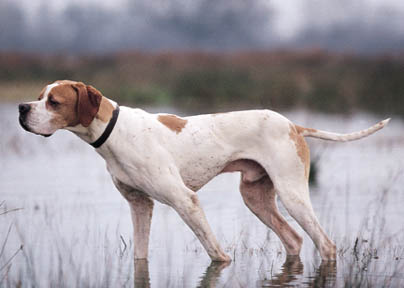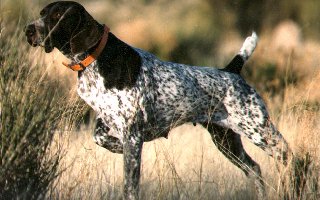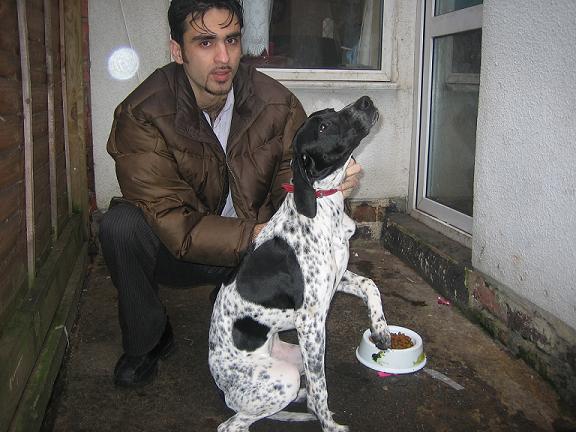|
|
|
 |
Pointer Dogs. |  |
|
History Of Pointer Dogs. The English Pointer was recognized by United Kennel Club in the early 1900's. General Appearance Characteristics Head Serious fault: Downface. SKULL - The skull is long and about half as wide as it is long. The cheeks are flat and well chiseled. Fault: Overly broad skull. MUZZLE - The muzzle must be sufficiently long to allow the dog to carry birds as large as pheasants and grouse. In profile, the muzzle is rectangular. The bridge of the muzzle may rise slightly from stop to nose or be level. Viewed from above, the muzzle is moderately wide with very little taper from stop to nose. Lips are slightly pendent but not overly thick, with pigment to match the nose. The top lip should fall naturally over the lower without folds or drooping, giving a squared appearance to the muzzle when viewed from the side. Fault: Short muzzle. TEETH - The English Pointer has a complete set of evenly spaced, white teeth meeting in a scissors or level bite. Faults: Crooked teeth; overshot or undershot bite. NOSE - The nose leather may be black or self-colored, depending on coat color. Nostrils must be large and open. Serious fault: Small or restricted nostrils. EYES - The eyes are oval with tight eyelids and pigment to match the nose color. Dogs with black pigment have dark eyes, the darker the better. Lighter-colored eyes are acceptable in dogs with self-colored pigment, but liver-colored dogs should preferably have darker eyes than lemon-colored dogs. The bony arches over the eyes are defined but should not be so excessive as to make the skull appear coarse. Expression is alert and intelligent. Faults: Slanted eyes; sagging eyelids making haw visible. EARS - The English Pointer's ear is another distinguishing mark of the breed. The ears are drop, short in length (reaching just below the lower jaw when hanging naturally) and set on just above eye level. They should be slightly pointed. The ear leather is thin enough that the veins in the ear are apparent. The outer side of the ear is covered with short, silky hair. At rest, the ears should hang nearly flat and close to the cheeks, with little or no fold. Faults: Long, low or rounded ears; thick ear leather. Neck Forequarters Faults: Straight shoulders; short upper arm; heavy, round bone; fine bone. Body The topline is mostly level, never exaggerated or overly sloped, with only a slight rise from the croup to the withers. The back is short, strong, and straight. The loin is strong, of moderate length, and slightly arched. The croup is slightly sloping. The ribs extend well back and are well sprung out from the spine, then curving down and inward. The forechest extends in a shallow oval shape in front of the forelegs. The chest is deep, reaching to the elbows, and of moderate width. Tuck-up is apparent but not exaggerated. Faults: Steeply sloping topline; croup too flat or to steep; tuck-up too exaggerated or absence of tuck-up; excessive skin or "skirting" in the tuck-up; short rib cage with long loin. Hindquarters Faults: Tilted pelvis resulting in tucked-under hindquarters; straight stifles; thin or poorly-developed second thigh. Feet Faults: Large, round feet; exaggerated hare feet; splayed feet. Tail Faults: Fat, non-tapering tail; tail carried with curl over the back; long tail. Disqualification: Docked tail. Coat Faults: Coat too thick and coarse or too thin and sleek; feathering; brushy tail. Color Height and Weight Desirable weight for a male in working condition is between 55 and 75 pounds, and between 44 and 65 pounds for a female. Balance and symmetry are more important than size, but great variations in size are undesirable. Gait |
||||
 English Pointer.
English Pointer. |
HISTORY OF THE GERMAN SHORTHAIRED POINTER by Noman Kamal As the name implies, the country of origin of this breed of dog was Germany. German Shorthaired Pointers have been known to be a distinct and separate breed probably since the 17th century. However, the dog that we identify as a GSP today was developed by a group made up of dedicated noblemen and sportsmen towards the end of the 19th century. It is important to note that these people had a very specific purpose in developing this breed. They wanted a personal gun dog, that could "sense, find, point, mark, and return game in the field and out of the water." They also wanted a companion and family dog. They wanted it all, a dog that could do anything. Prior to this time, noblemen would keep large kennels with a variety of dogs depending on what he wanted to hunt that day. Each dog would have a specialty, earth dogs, field dogs, water spaniels, etc. The philosophy of the developers of the GSP was "Those that have many dogs do not have any dogs." It is believed that these developers selectively bred to the German Pointer, the Spanish Pointer, the English Pointer, and various scent hounds until they arrived at what we know today as the German Shorthaired Pointer. |
|||
|
|
 German Shorthaired Pointer
|
|||
 My **ANNA **English Pointer(Femail). Six Month Old
|
||||